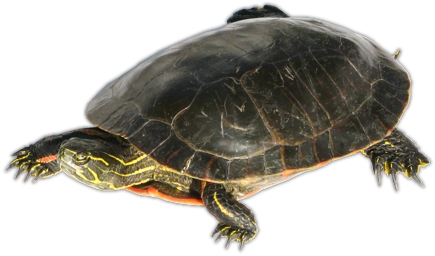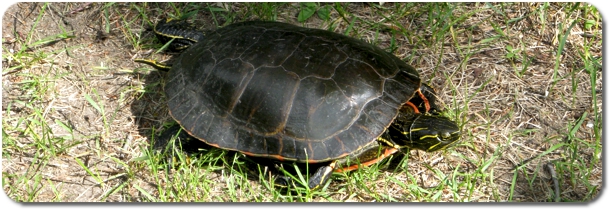Western Painted Turtle
What it looks like
The Western Painted Turtle is a medium sized turtle. They can grow to have a shell up to 25 cm long. The top of the shell is smooth and dark green to dark brown in colour. The bottom of the shell is yellow and orange with dark markings. On the head and legs there are bright yellow stripes. Females are larger than males.
Look-alikes
There are only two kinds of turtles in Manitoba. Western Painted Turtles have smooth shells, short tails and bright coloured stripes on their heads and necks and a bright coloured belly. Common Snapping Turtles are usually much larger than Western Painted Turtles. They have rough edges to their shells, long tails and necks, and are dark brown all over.
Name
The bright colours and patterns on this turtle's underside gives it the name Painted Turtle. There are other kinds of Painted Turtles in North America. The one that lives in the west, and here in Manitoba, is the Western Painted Turtle.
Scientific Name
The Western Painted Turtle's scientific name is Chrysemys picta belli. Learn what that means on this page: Scientific Names.
Where it lives
Western Painted Turtles live across much of central North America to southern Canada. In Manitoba they are found in the southern part of the province. These turtles live in ponds, rivers and lakes.
Where Western Painted Turtles live in North America.
Habits
Western Painted Turtles hunt for food in the water and are most active during the day. They spend a lot of time basking to warm themselves whenever the sun is out. In Manitoba they are active from April to October.
They spend winter on the bottom of larger water bodies that don't freeze to the bottom. Once there is ice on the water they must stop moving around as they can't get to the surface to breath air. In cold water they get oxygen through their skin. Western Painted Turtles sometimes move from large water bodies to smaller ponds in the summer to feed, then return to the larger water bodies for winter.

A female Western Painted Turtle on her way to a new pond
or looking for a place for a nest.
Food Web
Western Painted Turtles eat plants and animals they find in the water. They eat aquatic insects, snails, fish, tadpoles and many different plants. They will eat dead fish or other dead animals, too.
Adult turtles don't have many enemies as long as they don't go too far from water. They are too big to be eaten by fish and birds. Baby turtles are eaten by large fish and birds like herons.
Life Cycle
Western Painted Turtles mate in the spring. Females dig shallow nests in sandy or loose soils in June. They lay about 20 eggs at a time. Baby turtles stay in the nest over winter and come out in the spring. It takes at least 4 or 5 years for them to grow to adult size. They may live for more than 50 years.
Numbers
Western Painted Turtles are very common in southern Manitoba. There can be more than 20 turtles for every hectare of pond or lake.
Special Things
Adult Western Painted Turtles can survive over winter in ponds with almost no oxygen. Fish and frogs may die in ponds with no oxygen by late winter, but the turtles will survive. Baby turtles can survive being frozen in their nests over winter. The bright colours on the belly of baby turtles tells fish they are not good to eat. The babies will scratch the inside of a fish's mouth until they are spit out.
How to Find Western Painted Turtles
On sunny days look for turtles basking along the edge of water bodies. They prefer to bask on small islands or on logs or rocks close to the water's edge.
Use by People
Some people try to keep Western Painted Turtles as pets, but they should not be taken from the wild. Other than that these turtles aren't used by people.
| Go to: Northern Prairie Skink | Go back to: Amphibians and Reptiles Front Page |
For more on Painted Turtles in NatureNorth.com follow this link:
